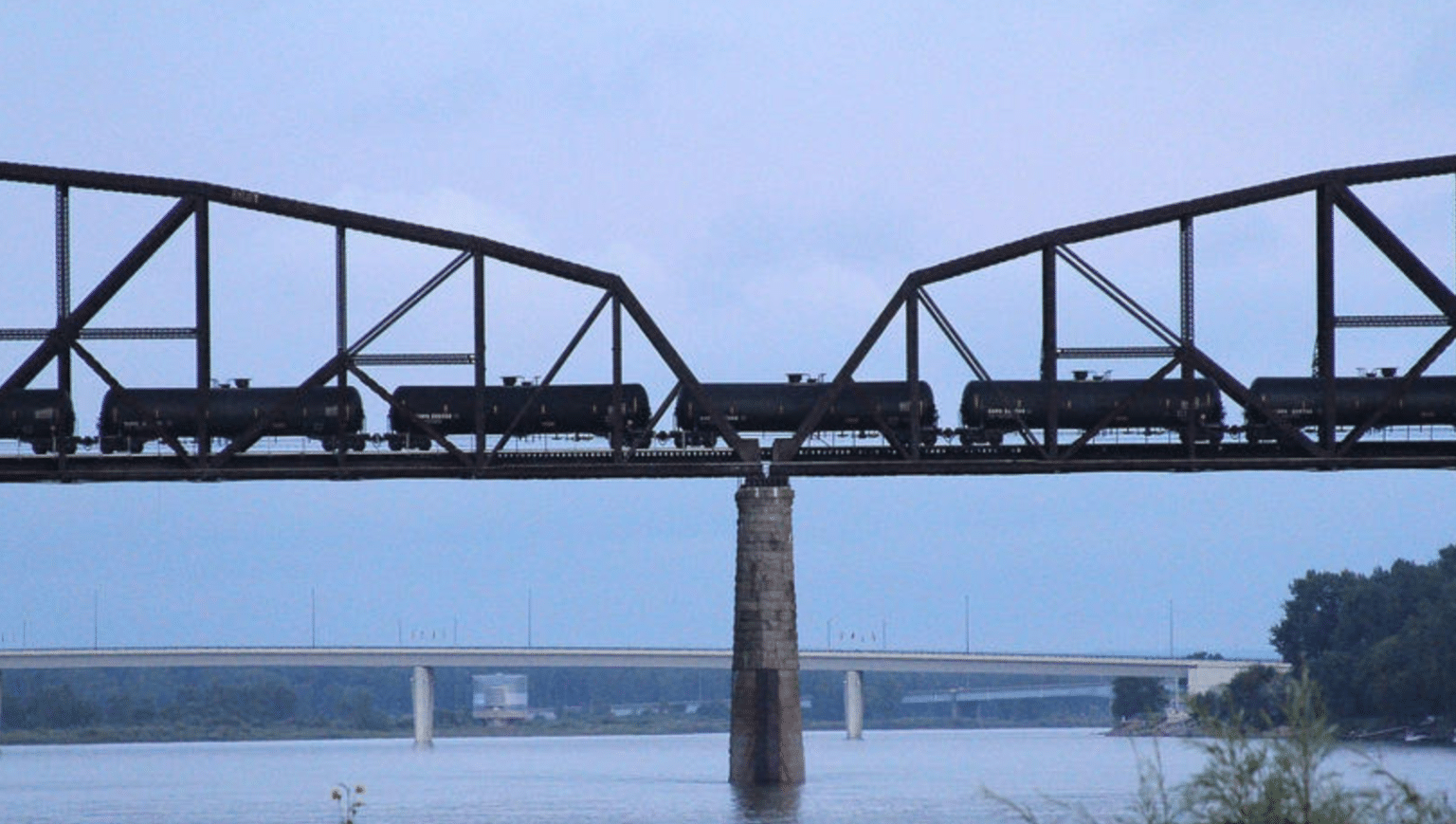Earlier this year the Association of American Railroads (AAR), the industry’s top lobbying group, produced a new report on rail safety. While the report ignored serious safety improvements such as requiring modernized braking systems on trains carrying hazardous materials, it did address one area of concern for oil-by-rail activists — rail bridge safety.
The section of the new AAR report on rail bridges opens with the statement “Don’t judge a book by its cover” — arguing that just because a bridge looks unsafe doesn’t mean it is. The report then goes on to describe industry programs to inspect rail bridges.
Railroads have been leaders in bridge safety practices for decades. In fact, long before the federal government began its highway bridge inspection program, the railroads inspected railroad bridges routinely. These inspections require detailed annual checks of each bridge. Safety inspectors sometimes need to scale bridges — often hundreds of feet in the air — to examine the health of bridge members and components.
So the rail industry claims detailed annual checks of each bridge are standard practice. Unfortunately that doesn’t seem to be the case. And even if it is the case, the industry has only allowed the public to “judge a book by its cover” because it wouldn’t share these reports with the public.
If you were a leader in “bridge safety practices” wouldn’t you be eager to share your work?
In 2015, Sarah Feinberg, Adminstrator of the Federal Railroad Administration, wrote a letter to the rail companies asking them to share information on bridges with local communities.
“When a local leader or elected official asks a railroad about the safety status of a railroad bridge, they deserve a timely and transparent response,” Feinberg wrote.
“I urge you to engage more directly with local leaders and provide more timely information to assure the community that the bridges in their communities are safe and structurally sound.”
How did the rail industry respond? By ignoring the requests and Feinberg’s letter. So, all the public had to go on is the report produced by the industry lobbyists saying the bridges are safe.
At the same time the industry was ignoring Feinberg’s request, Waterkeeper Alliance, ForestEthics, Riverkeeper and a national network of Waterkeeper organizations released an investigative report — DEADLY CROSSING: Neglected Bridges & Exploding Oil Trains — exploring the condition of the nation’s rail infrastructure and how it is impacted by oil train traffic.
The report reviewed 250 bridges and identified potential problems in close to half. It also noted that the current practice of allowing rail companies to inspect their own bridges was problematic.
“Do truckers get to inspect their own trucks? Do you get to inspect your own car? Of course not. So it’s insane, and completely unacceptable, that the rail industry gets to inspect its own infrastructure while moving cargo that is of such enormous risk to American citizens and the environment,” said Riverkeeper boat captain John Lipscomb.
New Rail Bridge Regulations
The FAST Act transportation bill included several sections addressing oil-by-rail safety and while some have the potential to weaken future safety regulations the section on rail bridge inspection reports addressed the industry’s refusal to share this information with the public.
Whereas the other issues potentially won’t be addressed for years, the Federal Railroad Administration acted quickly regarding rail bridge inspection reports. Last week, the FRA launched a section on its website that allows elected officials to request copies of rail bridge inspection reports.
Riverkeeper attorney Sean Dixon commented to DeSmog on the new regulation and website:
“Allowing local officials – in certain circumstances – to request by email some safety aspects of railroad bridges is an important but limited step toward transparency, but it’s only the first step,” Dixon said. “We’re glad the FRA Administrator took such quick action to implement the FAST Act, but we’ll be looking to her agency to push for more federal and state bridge inspections, national bridge safety standards, and more thorough federal enforcement and oversight, immediately.”
The Federal Railroad Administration budget for 2017 does propose doubling the number of rail inspectors from 8 to 16 and also proposes developing a national inventory of rail bridge inspection history.
As has been the case with most major areas for safety improvements in moving oil-by-rail, the rail industry has fought against transparency regarding rail bridges. Instead they rely on industry sponsored reports saying everything is fine. For now, it appears some progress has been made on the issue.
New York Sen. Chuck Schumer has been advocating for stronger oil-by-rail regulations and more inspectors and is supporting the FRA proposals which he called for earlier this year, as reported by Progressive Railroading.
“Many train bridges across the region are deteriorating, including two in Cornwall where the concrete foundation has eroded, vertical cracks have emerged, rebar has become exposed, and bolts that have become loose or have fallen off altogether,” Schumer said. “Any problem with their structural integrity could lead to a disaster of epic proportions and we must do all we can to avoid that nightmare scenario.”
In a press release supporting the FRA budget proposals Schumer said, “It shouldn’t take tragic derailment or a horrific rail-bridge collapse to get Congress to invest in more rail safety inspectors.”
Unfortunately, in an industry where the conventional wisdom is that “the rules are written in blood”, typically some type of disaster is what it takes to get meaningful new safety regulations.
Blog image credit: Dustin Monke – The Dickinson Press
Subscribe to our newsletter
Stay up to date with DeSmog news and alerts






